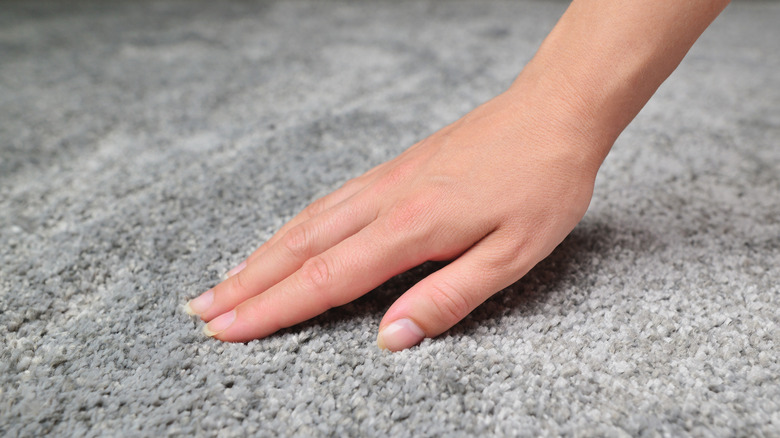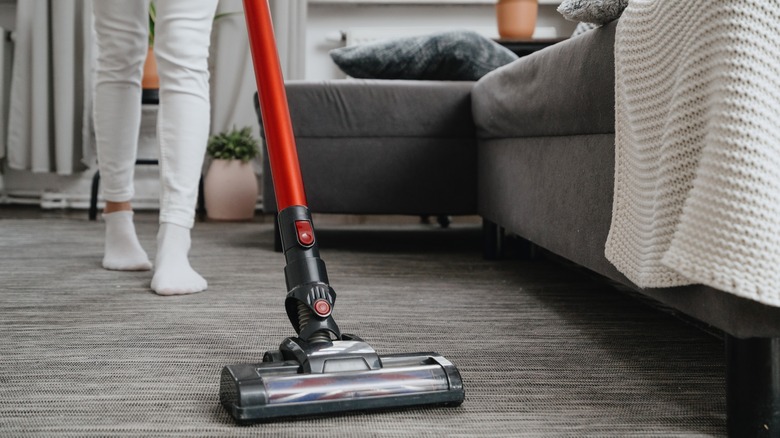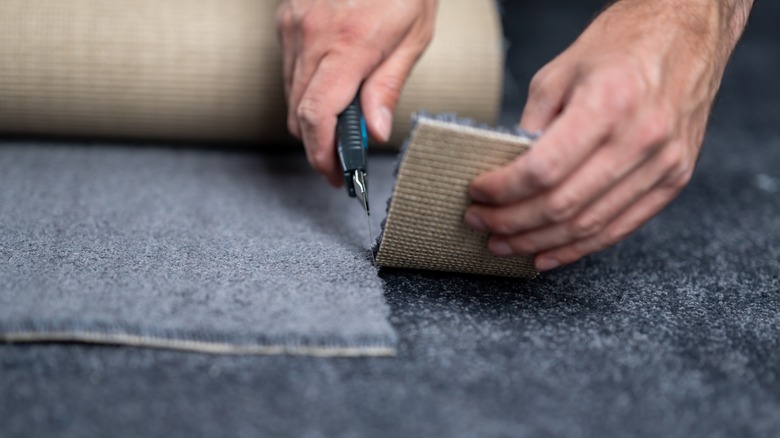The Good (And Bad) News About Formaldehyde In Your Home's Carpet
Homeowners are getting rid of the carpets of yore in their houses for many reasons, but one of the big ones is the challenge to consistently keep carpets clean. Carpets are a magnet for mess, dirt, and untidiness, especially if you have pets or little ones. However, carpet choices are evolving and it could be making a big comeback, regardless of its upkeep. But there's something you should be aware of if you choose to install new carpet or keep existing carpet in your home.
Volatile organic compounds (VOCs), the most infamous of which is formaldehyde, may be lingering on carpets when you first install them (that's that new carpet smell!) or if you've neglected to clean them in some time. While formaldehyde is no longer used in the manufacturing of carpets, carpets can absorb and harbor chemicals and VOCs from other sources like building materials (plywood, particle wood, and laminate flooring), household cleaners and products, and dry cleaned textiles. If you haven't deep cleaned your carpets in a while or if you don't vacuum regularly, formaldehyde or similar VOCs can settle into your carpet, and then re-emit them from your floors when disturbed.
Furthermore, other non-formaldehyde VOCs are still used in carpet manufacturing, so initially, there may be traces of that substance left in carpet fibers. Proper room ventilation will decrease risk of those VOCs affecting air quality, but home owners should be diligent. Luckily there are plenty of ways to mitigate formaldehyde.
Bad news: VOCs and formaldehyde can be in your carpets
VOCs can emit into the air as gas, or off-gas, from different chemicals used in household products and in building materials, including paint, dry-cleaned clothing, and furniture. Where carpet is concerned, new carpets will off-gas VOCs when installed due to the systems' chemical adhesives and cushion materials. Existing carpets can also still harbor VOCs after installation, since carpets readily absorb from other off-gassing products. Mold spores, lead particles, pet dander, insect waste — all of these pollutants can exist in a carpet's ecosystem. Formaldehyde, specifically, makes its way onto your floor from those household materials that harbor other VOCs too, like the aforementioned dry cleaned textiles and new building materials. Without proper maintenance, carpets can re-release these lingering pollutants into the air, kicked up by regular movement in the home.
VOCs that settle into your carpet from these sources can cause mild symptoms, like headaches, dizziness, and nausea, but long-term exposure can detrimentally impact your lungs and other organs, according to the American Lung Association. Proper carpet care — like good ventilation, annual deep cleanings, and regular vacuuming — can mitigate VOC-related health issues. In maintaining good carpet cleaning habits, you'll be removing more than just VOCs, but also all those other allergens and debris that sink into carpets too. A healthy habit all around!
Good news: there are ways to prevent VOCs in your home
The good news here is that keeping VOCs and formaldehyde at bay in your home is completely possible. First, when initially installing new building material, including carpet, you need to maintain excellent ventilation in the space. Keep windows, and even doors if possible, open to increase air flow between 24 to 48 hours after installation. VOCs from new carpets drastically dissipate in that time period. Storing carpets outside prior to installation can also decrease VOCs inside the house as it allows them to off-gas in the open air, rather than in a confined space.
Since VOCs may continue to off-gas for several years after installation, purchasing an air purifier or HEPA filters for your vacuums can be helpful in decreasing airborne toxins. Consistent carpet cleaning will also reduce lingering VOCs. Of course, whenever you clean and use substances that may carry VOCs, keep your space well-ventilated so that those gasses and particles aren't settling back down in your carpet.
Everyone makes some common mistakes when deep cleaning their carpets, like improperly treating stains for the material of your carpet or not knowing the fiber type, so be mindful with how you tackle cleaning. Remember, your area rugs are carpets too, so be sure to give your rugs a deeper clean as well. All of this will ensure a healthy living environment that you can feel safe breathing in.


